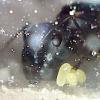I caught this queen back in September. I caught 2 but one died in fridge and I took this one out about 2 weeks ago.
She had been in my beer fridge for 2 months in a test tube and was recently moved to Grotube but was again relocated to Tar Heel Ants' growth chamber about 2 days ago.
And today, I saw she finally laid eggs !
So, this journal begins. ![]()
The first thing she did when she was placed in a growth chamber was blocking off the entrance within minutes.
Edited by dean_k, January 30 2015 - 10:14 AM.


















